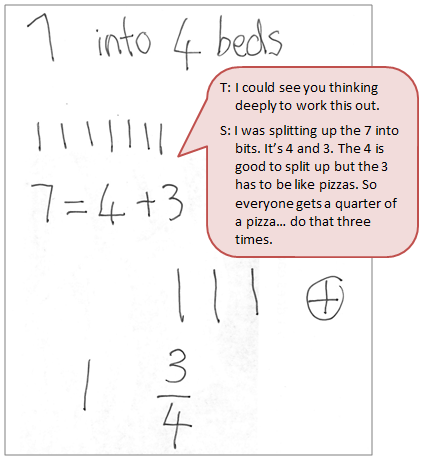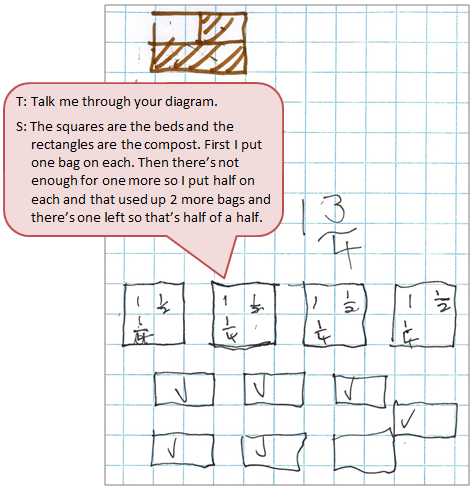The purpose of this activity is to engage students in carrying out a division, where the solution is not a whole number.
This activity assumes the students have experience in the following areas:
- Partitioning whole numbers to make calculations easier.
- Creating equi-partitioning models for fractions to make sense of the numerator and denominator.
- Finding fractions of sets.
- Adding simple fractions with the same denominators.
The problem is sufficiently open ended to allow the students freedom of choice in their approach. It may be scaffolded with guidance that leads to a solution, and/or the students might be given the opportunity to solve the problem independently.
The example responses at the end of the resource give an indication of the kind of response to expect from students who approach the problem in particular ways.
A gardener has 7 bags of compost to spread evenly over 4 flower beds.
How many bags of compost does each bed get?
The following prompts illustrate how this activity can be structured around the phases of the Mathematics Investigation Cycle.
Make sense
Introduce the problem. Allow students time to read it and discuss in pairs or small groups.
- Do I understand the situation and the words? (Students may need support to understand the meaning problem. Acting out the sharing may be needed.)
- Can I represent the problem as a number operation? (Students may not connect this problem to division by equal sharing, i.e., 7 ÷ 4 = ?)
- What do I expect to be difficult about this problem?
- What will my solution look like? (The solution will be the number of bags spread of a single garden, with clear explanation of how the answer was found.)
Plan approach
Discuss ideas about how to solve the problem. Emphasise that, in the planning phase, you want students to say how they would solve the problem, not to actually solve it.
- What strategies will be useful to solve a problem like this? (Acting out, drawing a diagram, making a model, trying a simpler problem, and writing an equation are all possible strategies.)
- Do I have some idea of how many bags each garden will get? How do I know that?
- Will the shares be in whole bags or fractions of bags? How do you know?
- What tools (digital or physical) could help my investigation? Will a calculator be useful?
Take action
Allow students time to work through their strategy and find a solution to the problem.
- Have I shown my workings in a step-by-step way?
- Is the working clear so I can follow it and look for any patterns?
- Have I found a solution? Is my solution sensible? How do I know?
- How can I express my solution using numbers and words?
- Does my strategy work for other equal sharing situations?
- How do my results look different or different to others? Why could this be?
- What are the most efficient ways to solve the problem?
Convince yourself and others
Allow students time to check their answers and then either have them pair share with other groups or ask for volunteers to share their solution with the class.
- Is my working clear for someone else to follow?
- Did I try other strategies that give me confidence in my solution?
- How would I convince someone else I am correct?
- Is my solution expressed in a mathematical way? Do I need to learn some maths about how to express what I found?
- Would my strategy work in a different equal sharing situation? How?
Examples of work
Work sample 1
The student creates a diagram of tally marks to track the allocation of bags to garden beds. They recognise that 3 bags shared among 4 gardens gives a share of ¾.
Click on the image to enlarge it. Click again to close.
Work sample 2
The student draws a regions model and divides the areas up equally to work out the share of bags per garden bed.


